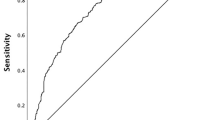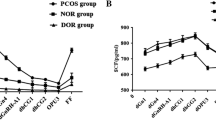Abstract
Purpose
To establish an index to predict ART outcomes and to identify infertile patients who need LH supplementation during ovarian stimulation.
Methods
Serum LH concentrations were measured during the mid- and late-follicular phase in 86 normogonadotropic infertile patients who underwent ART treatment using GnRH-agonist long protocol with recombinant-FSH. The relationships between serum LH concentrations at both time points and ART outcomes were retrospectively analyzed, and the relationships between the ratio of late-follicular to mid-follicular LH concentrations and ART outcomes were also evaluated.
Results
There were no significant correlations between the mid- or late-follicular LH concentrations and ART outcomes. The ratio of late-follicular to mid-follicular LH concentrations <1.0 was considered the relatively LH decreased group (RD group) and ratio ≥ 1.0 was considered the relatively LH increased group (RI group). The number of usable embryos in RD group was similar to that in RI group, but the pregnancy and implantation rates in the RD group (9.7% and 5.8%) were significantly lower than those in the RI group (31.1% and 17.2%; p < 0.05).
Conclusions
Relatively decreased LH concentrations during ovarian stimulation using GnRH-agonist long protocol with rec-FSH had a negative effect on ART outcomes. Therefore, the ratio of mid- to late-follicular phase LH concentrations is suggested to be an efficient index to identify patients who might benefit from LH supplementation.
Similar content being viewed by others
References
Wildt L, Diedrich K, van der Ven H, al Hasani S, Hubner H, Klasen R. Ovarian hyperstimulation for in-vitro fertilization controlled by GnRH agonist administered in combination with human menopausal gonadotrophins. Hum Reprod. 1986;1:15–9.
Devroy P, Mannaerts B, Smitz J, Coelingh Bennink H, Van Steirteghem A. Clinical outcome of a pilot efficacy study on recombinant human follicle-stimulating hormone (Org 32489) combined with various gonadotropin-releasing hormone agonist regimens. Hum Reprod. 1994;9:1064–9.
Cabrera RA, Stadtmauer L, Mayer JF, Gibbons WE, Oehninger S. Follicular phase serum levels of luteinizing hormone do not influence delivery rates in in vitro fertilization cycles down-regulated with a gonadotropin-releasing hormone agonist and stimulated with recombinant follicle-stimulating hormone. Fertil Steril. 2005;83:42–8. doi:10.1016/j.fertnstert.2004.06.050.
Kolibianakis EM, Collins J, Tarlatzis B, Papanikolous E, Devroy P. Are endogenous LH levels during ovarian stimulation for IVF using GnRH analogues associated with the probability of ongoing pregnancy? A systematic review. Hum Reprod Update. 2006;12:3–12. doi:10.1093/humupd/dmi030.
Fleming R, Lloyd F, Herbert M, Fenwick J, Griffiths T, Murdoch A. Effects of profound suppression of luteinizing hormone during ovarian stimulation on follicular activity, oocyte and embryo function in cycles stimulated with purified follicle stimulating hormone. Hum Reprod. 1998;13:1788–92. doi:10.1093/humrep/13.7.1788.
Westergaard LG, Laursen SB, Andersen CY. Increased risk of early pregnancy loss by profound suppression of luteinizing hormone during ovarian stimulation in normogonadotrophic women undergoing assisted reproduction. Hum Reprod. 2000;15:1003–8. doi:10.1093/humrep/15.5.1003.
Balasch J, Vidal E, Peñarrubia J, Casamitjana R, Carmona F, Creus M, et al. Suppression of LH during ovarian stimulation: analyzing threshold values and effects on ovarian response and the outcome of assisted reproduction in down-regulated women stimulated with recombinant FSH. Hum Reprod. 2001;16:1636–43. doi:10.1093/humrep/16.8.1636.
Esposito MA, Barnhart KT, Coutifaris C, Patrizio P. Role of periovulatory luteinizing hormone concentrations during assisted reproductive technology cycles stimulated exclusively with recombinant follicle-stimulating hormone. Fertil Steril. 2001;75:519–24. doi:10.1016/S0015-0282(00)01745-3.
Humaidan P, Bungum L, Bungum M, Andersen CY. Ovarian response and pregnancy outcome related to mid-follicular LH levels in women undergoing assisted reproduction with GnRH agonist down-regulation and recombinant FSH stimulation. Hum Reprod. 2002;17:2016–21. doi:10.1093/humrep/17.8.2016.
Humaidan P, Bungum M, Bungum L, Yding Andersen C. Effects of recombinant LH supplementation in women undergoing assisted reproduction with GnRH agonist down-regulation and stimulation with recombinant FSH: on opening study. Reprod Biomed Online. 2004;8:635–43.
Humaidan P. To add or not to add LH: comments on a recent commentary. Reprod Biomed Online. 2006;12:284–5.
Nakagawa K, Ohgi S, Kojima R, Sugawara K, Horikawa T, Ito M, I Irahara M, Saito H. Recombinant-FSH has more effective potent than urinary human menopausal gonadotropin in ovarian hyperstimulation for ART treatment. Reprod Med Biol. 2007;6:27–32. doi:10.1111/j.1447-0578.2007.00161.x.
Nakagawa K, Ohgi S, Kojima R, Ito M, Horikawa T, Irahara M, et al. Reduction of perifollicular arterial blood flow resistance after hCG administration is a good indicator of the recovery of mature oocytes in ART treatment. J Assist Reprod Genet. 2006;23:433–8. doi:10.1007/s10815-006-9087-4.
Nakagawa K, Yamano S, Moride N, Yamashita M, Yoshizawa M, Aono T. Effect of activation with Ca ionophore A23187 and puromycin on the development of human oocytes that failed to fertilize after intracytoplasmic sperm injection. Fertil Steril. 2001;76:148–52. doi:10.1016/S0015-0282(01)01839-8.
The European recombinant human LH study group. Recombinant human luteinizing hormone (LH) to support recombinant human follicle-stimulating hormone (FSH)-induced folliclar development in LH- and FSH-deficient anovulatory women: a dose-finding study. J Clin Endocrinol Metab 1998;83:1507–14. doi:10.1210/jc.83.5.1507.
Shoham Z, Balen A, Patel A, Jacobs HS. Results of ovulation induction using human menopausal gonadotropin or purified follicle-stimulating hormone in hypogonadotorpic hypogonadism patients. Fertil Steril. 1991;56:1048–53.
Lauoud R, Al-Jefout M, Tyler J, Ryan J, Driscoll G. A relative reduction in mid-follicular LH concentrations during GnRH agonist IVF/ICSI cycles leads to lower live birth rates. Hum Reprod. 2006;21:2645–9. doi:10.1093/humrep/del219.
Kol S. To add or not to add LH: consideration of LH concentration changes in individual patients. Reprod Biomed Online. 2005;11:664–6.
Author information
Authors and Affiliations
Corresponding author
Additional information
Capsule A relative decrease in LH concentration during ovarian stimulation in a GnRH-a long protocol negatively affected the ART outcomes. This ratio can be used to identify patients who need LH supplementation.
Rights and permissions
About this article
Cite this article
Nakagawa, K., Ohgi, S., Nakashima, A. et al. The ratio of late-follicular to mid-follicular phase LH concentrations efficiently predicts ART outcomes in women undergoing ART treatment with GnRH-agonist long protocol and stimulation with recombinant FSH. J Assist Reprod Genet 25, 359–364 (2008). https://doi.org/10.1007/s10815-008-9243-0
Received:
Accepted:
Published:
Issue Date:
DOI: https://doi.org/10.1007/s10815-008-9243-0




